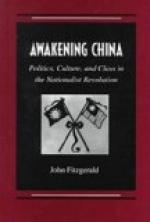On a broad estuary near the mouth of the main artery that penetrates the heart of China, it has become a leading emporium of the world’s commerce. The native city still hides its squalor behind low walls of brick, but outside the North Gate lies a tract of land known as the “Foreign Concessions.” There a beautiful city styled the “model settlement” has sprung up like a gorgeous pond-lily from the muddy, [Page 27] paddy-fields. Having spent a year there, I regard it with a sort of affection as one of my Oriental homes.
Shanghai presents a spectacle rare amongst the seaports of the world. Its broad streets, well kept and soon to be provided with electric trolleys, extend for miles along the banks of two rivers, lined with opulent business houses and luxurious mansions, most of the latter being surrounded by gardens and embowered in groves of flowering trees. Nor do these magazines and dwelling-houses stand merely for taste and opulence. Within the bounds of the Concessions is the reign of law—not, as elsewhere in China, the arbitrary will of a magistrate, but the offspring of freedom and justice. Foreigners live everywhere under the protection of their own national flags: and within the Concessions. Chinese accused of crimes are tried by a mixed court which serves as an object-lesson in justice and humanity. Had one time to peep into a native yamen, one might see bundles of bamboos, large and small, prepared for the bastinado; one might see, also, thumb-screws, wooden boots, wooden collars, and other instruments of torture, some of them intended to make mince-meat of the human body. The use of these has now been forbidden.[*]
[Footnote *: In another city a farmer having extorted a sum of money from a tailor living within the Concession, the latter appealed to the British consul for Justice. The consul, an inexperienced young man, observing that the case concerned only the Chinese, referred it to the city magistrate, who instantly ordered the tailor to receive a hundred blows for having applied to a foreign court.]
In Shanghai there are schools of all grades, some under the foreign municipal government, others under missionary societies. St. John’s College (U. S. [Page 28] Episcopal) and the Anglo-Chinese College (American M. E.) bear the palm in the line of education so long borne by the Roman Catholics of Siccawei. Added to these, newspapers foreign and native—the latter exercising a freedom of opinion impossible beyond the limits of this city of refuge—the Society for the Diffusion of Christian Knowledge and other translation bureaux, foreign and native, turning out books by the thousand with the aid of steam presses, form a combination of forces to which China is no longer insensible.
Resuming our imaginary voyage we proceed northward, and in the space of an hour find ourselves at the mouth of the Yang-tse Kiang, or Ta Kiang, the “Great River,” as the Chinese call it. The width of its embouchure suggests an Asiatic rival of the Amazon and La Plata. We now see why this part of the ocean is sometimes described as the Yellow Sea. A river whose volume, it is said, equals that of two hundred and forty-four such rivulets as Father Thames, pours into it its muddy waters, making new islands and advancing the shore far into the domain of Neptune.




